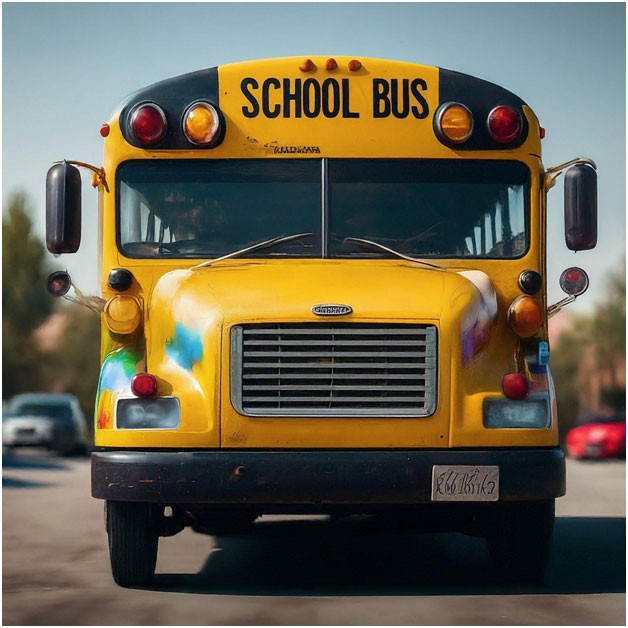
Image by Gemini
Today more than 480,000 school buses are operating in the United States alone, a mighty fleet that helps more than 26 million students ride to and from school each year. It is typical for a school bus to be in service for around twelve years, after which the school districts can receive funding from the government for a replacement. However, other factors can make a bus’ school life even shorter, such as changing accessibility requirements and environmental regulations. When it comes time for a vehicle to end its journey as a school bus, it can often have a lot of life left in it. Once they are retired, school buses are usually sold to private buyers at auctions, through dealerships, or even on websites like eBay and Craigslist. These vehicles typically cost between $5,000 and $15,000, depending on factors like make, year, and condition. In recent years, there has been a growing trend of repurposing retired school buses and giving them a new and creative function. Often, school bus reuse projects turn into great and sustainable community-driven solutions for existing problems. From libraries on wheels to mobile health clinics to tiny homes, discover specific and inspiring examples of repurposed school buses and their positive impact.
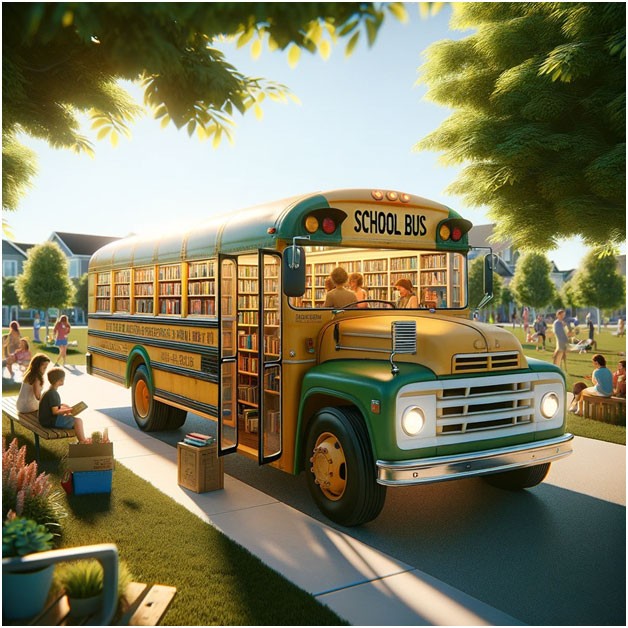
Image by Dall-E
Mobile Libraries on Wheels
One creative way retired school buses can be used to promote literacy and access to reading materials is through mobile libraries on wheels. In mobile library projects, the vehicle’s function is changed from transporting kids to transporting books. Mobile libraries allow more people throughout a community to have access to books, and they also allow schools to share resources efficiently.In many cases, mobile library projects are undertaken by schools themselves. In 2018, Cincinnati College Preparatory School in Cincinnati, Ohio transformed one of their old school buses into a mobile library. The project involved removing all the seats from the vehicle’s interior, installing bookshelves, covering the walls with colorful paint, and adding comfortable furniture for children and community members to sit on and read.One of the most heartwarming aspects of Cincinnati College Preparatory School’s mobile library project was its impact on the Greater Cincinnati Community. While the colorful vehicle is owned by and associated with the school, kids do not have to be enrolled to visit the library or take a book home. Overall, this school bus reuse project was an excellent way to give an old vehicle a new life and get kids (and adults) excited about reading.
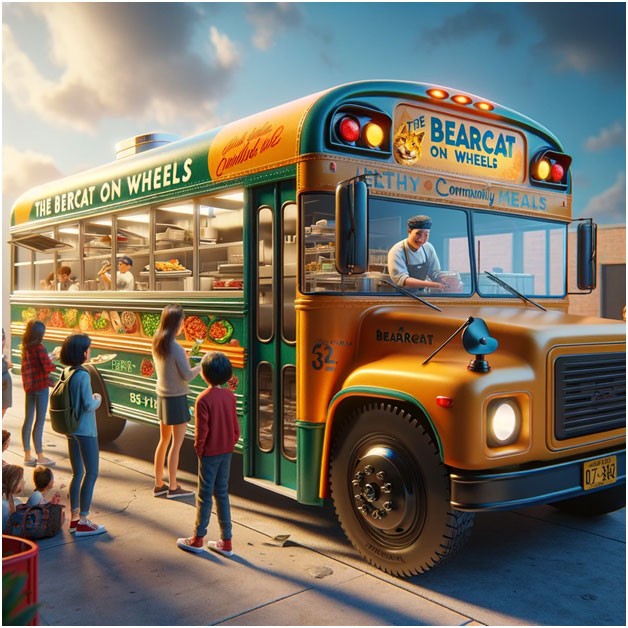
Image by Dall-E
Food Trucks with a Purpose
Old school buses can also be used to promote healthy, sustainable eating and support local producers. A popular way to transform former buses and large public vehicles is to convert them into food trucks. While a food truck can be a great independent commercial project, there are also cases where they are used to serve a greater need within a community. In 2020, the Sherman Independent School District in Sherman, Texas remodeled one of its school buses into a food truck called “The Bearcat on Wheels.” This project entailed removing the seats from the interior of the bus, installing new kitchen equipment, and giving the school bus a fresh and fun coat of paint. Because food truck conversions involve purchasing kitchen equipment, one challenge that comes with them is the higher initial monetary investment for the project. However, once the food truck is operating, it has incredible potential to make an impact on the community. In addition to being a fun way to serve healthy meals to students, the Bearcat on Wheels supported the Sherman community during the COVID-19 pandemic by providing curbside meals to students and families throughout the year.
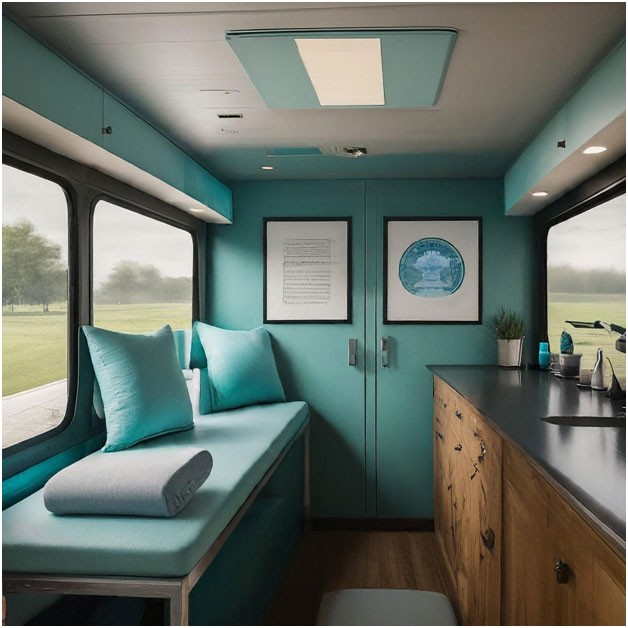
Image by Gemini
Wellness on Wheels
Another great way school bus reuse projects can give back to their local communities is through mobile health clinics, which improve access to healthcare. Mobile health clinics are a staple in the worldwide medical community, and the World Health Organization regularly funds and deploys these vehicles to help vulnerable communities around the world.The idea of turning a school bus into a medical clinic is not new; one dentist on Hornby Island, British Columbia has been operating his practice out of a retired school bus for more than 35 years. Canadian dentist Dr. Peter Walford spent four years and $60,000 CAD to convert an old school bus into a dental clinic, doing most of the repairs and conversions himself and installing brand-new dental equipment. Now, he spends working days driving to patients across Hornby Island and the neighboring Denman Island.In addition to widely increasing dental access in a previously underserved community, Dr. Walford’s mobile dental clinic also improves sustainability in a critical area of Canada’s natural environment. Prior to the mobile clinic, residents of the islands had to travel up to 50 miles round trip to receive dental care in the larger city of Courtenay, British Columbia. Now, Dr. Walford is able to provide care to the area with fewer carbon emissions and without needing to establish a brick-and-mortar practice on either island.
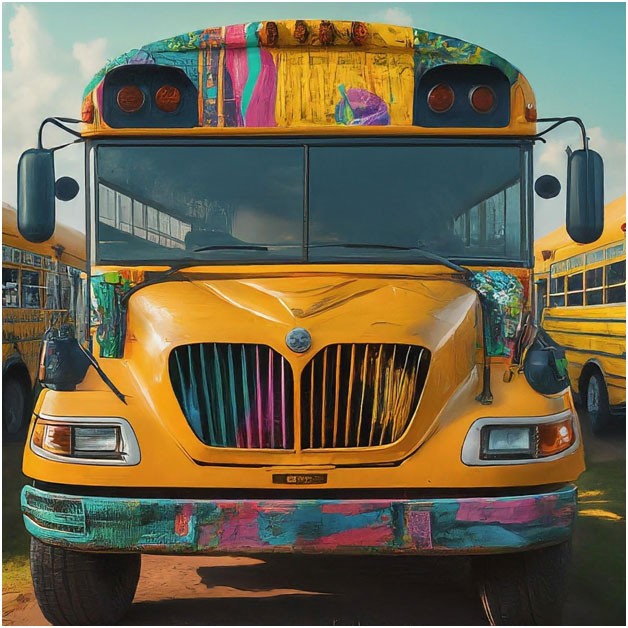
Image by Gemini
Rolling Art Studios
Retired school buses also have ample space to create art studios, and their mobile nature allows for art experiences to be more accessible. Access to artwork is important for community expression, and rolling art studios can be an innovative way for local artists to increase their outreach. Mobile studios can be a great option for artists in cities with limited space and a high cost of living.Erica Cantua, an artist from Arizona, purchased a school bus on Craigslist in 2022 and created her own mobile art studio. The project took a year to complete, and she regularly performs maintenance on the vehicle to make sure it runs smoothly despite its age. For Cantua, the mobile art studio was a solution to her sales dropping dramatically during the pandemic, and working out of the bus has been a great solution.Rolling art studios like Erica Cantua’s can be a great opportunity for community enrichment, as artists with these vehicles can easily visit artisan markets and street fairs to bring art to the public. These vehicles are also a great attraction for charity events, and the large size of a decommissioned school bus can accommodate community art workshops as well.
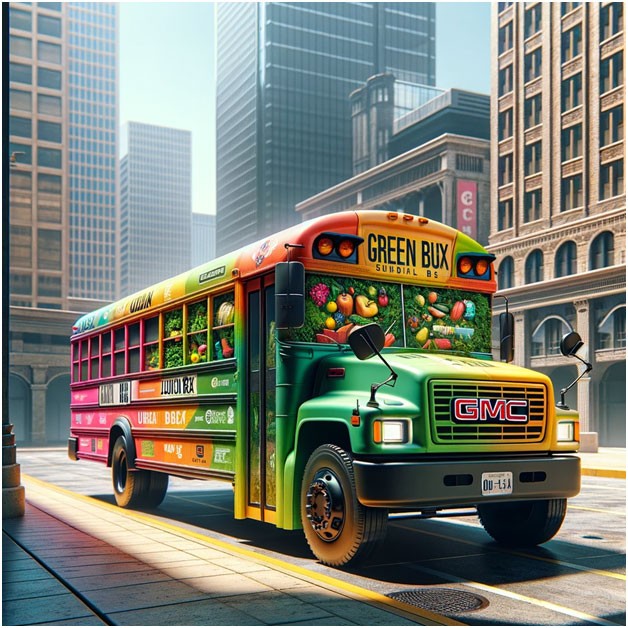
Image by Dall-E
Mobile Gardens
A sustainable solution for school buses nearing the end of their life is to turn them into mobile garden centers. These green machines are a great opportunity for community education on sustainability and urban greening. In big cities with little green space, these mobile units are a great solution to get kids and adults alike learning about the challenges of growing food in an urban environment.In 2012, a mobile garden education center called the Green Urban Lunch Box was established in Salt Lake City, Utah. Once a 35-foot school bus, this vehicle was refurbished to include a drip irrigation system and a solar-powered hydroponics system. Members of the project team traveled around the city to promote urban gardening, hand out free seeds, and teach children and community members about how to grow their own food.
Mobile gardens also work well in conjunction with farm box programs, which support local farmers and deliver fresh produce weekly around the city. These vehicles are also great for transporting supplies between established community gardens throughout an urban environment and are great attractions for hosting community garden workshops.
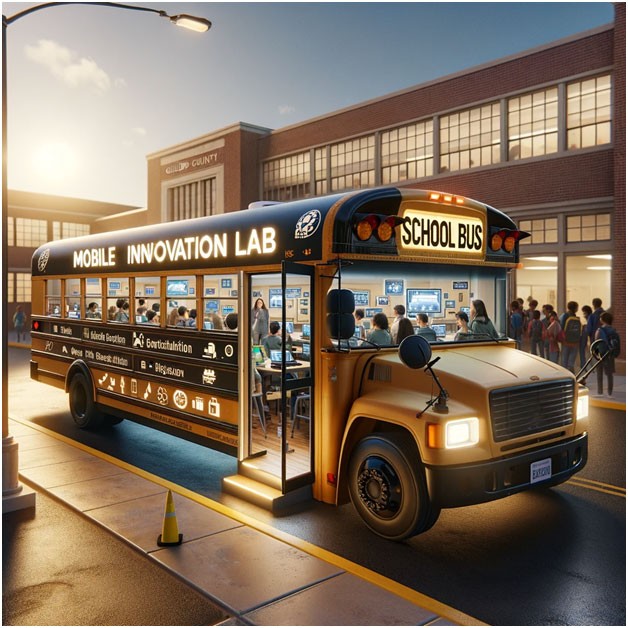
Image by Dall-E
Tech Hubs on Tour
Mobile tech learning centers are a great way to bridge the digital divide, especially in communities with large populations of underserved youth. There is plenty of space inside the average retiring school bus to host computer workshops, engineering classes, and other STEM-related activities. Digital equipment can be expensive, and mobile tech hubs are a great way to share devices, resources, and knowledge throughout a community.In Guilford County, North Carolina, an old school bus was converted into a tech lab for middle schoolers called the Mobile Innovation Lab. This tech maker space was created to bridge a gap in the district’s middle school STEM program and travels between Guilford County middle schools to teach hands-on lessons in science, technology, engineering, the arts, and mathematics. In one exciting lesson, students could build their own Bluetooth speakers with the capability to connect to Wi-Fi networks.These tech hubs on wheels are a great example of school buses being converted for further use within a school district. There is much innovative potential in STEM-related fields, and projects like these can repurpose existing resources for future-thinking education.

Image by Dall-E
Tiny Homes: Eco-Friendly Living Spaces
One of the most popular options for converting a school bus is for housing purposes. Tiny
homes are eco-friendly living spaces, and the amount of retired school buses for sale each year creates an abundance of sustainable and minimalist living opportunities. A standard full-size school bus in the United States is about 35 feet long, providing a good amount of space to create a unique and creative residence. One unique school bus tiny home project was created by filmmaker Felix Starck and musician Selima Taibi as a loft-style residence for their travels along the Panamerican highway. The couple purchased a 39-foot 1996 Thomas International School bus and spent 12 weeks on the conversion, titling the project “Expedition Happiness.” Along with their dog Rudi, Felix and Selima traveled in the mobile tiny home from Alaska to Mexico, making a documentary about the experience along the way.
Many people have successfully created tiny home residences in retired school buses, ranging from college students to couples like Felix and Selima to families with children. Although retired buses lean towards being a standard size, there are varied options on the resale market that allow for countless tiny home configuration possibilities. With housing and cost of living crises at the forefront of many communities, tiny homes are a great solution to many problems facing people’s lives across America and the world.
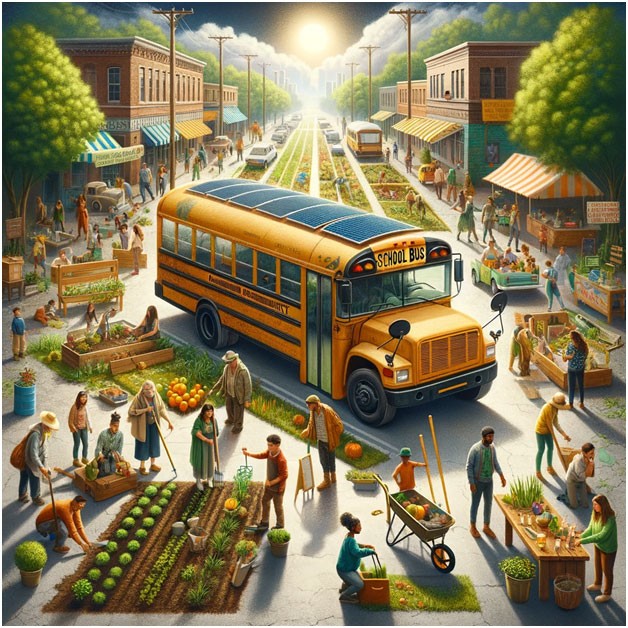
Image by Dall-E
Benefits of School Bus Reuse
As can be seen from these inspirational projects, there are so many creative ways for school buses to be repurposed for positive impact. Some of the broader benefits of these types of projects include:
- Environmental Sustainability: Because so many school buses are retired or made obsolete each year, reuse projects contribute greatly to waste reduction. The resources used to build automobiles like school buses are limited, and it is a good sustainable practice to ensure that vehicles are not scrapped or junked until it is absolutely necessary.
- Community Development: Many school bus conversion projects involve increasing community access to resources or creating economic opportunities for local people and businesses. Programs associated with school bus reuse projects have endless possibilities for inspiring communities and bringing people together.
- Creativity and Innovation in Problem-Solving: As can be seen from the variety of school bus reuse projects presented, retired school buses are great platforms for creativity and innovation in problem solving. The repurposing of these vehicles is not only a practical solution that utilizes existing resources, but it also sparks the imagination.
Conclusion
With so many school buses retiring each year across the United States and the world, creative school bus reuse projects have a massive potential to create a positive impact. Every community is different and has its own needs, and refurbishment projects like these can provide creative solutions and enrich the experience of living in a community. These projects serve broad practical purposes, but they also inspire sustainable practices and innovation in people of all ages. While there is a wide variety of school bus reuse projects featured here, they all have one thing in common: they were created by community members who stepped up and wanted to make a difference. Anyone can foster positive change in their neighborhood by harnessing creativity and the power of problem-solving to give an old school bus a new life.



